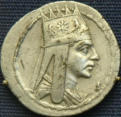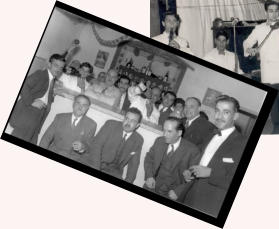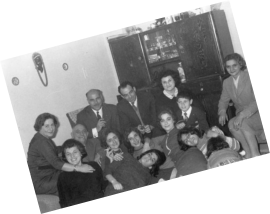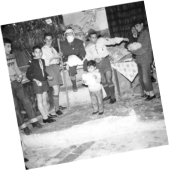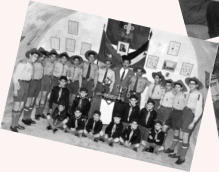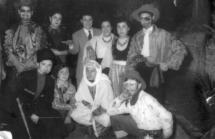

For the greater part of the past century, the Jerusalem Armenian
Benevolent Union (JABU), popularly known the "Agoump" (club),
continued to act as the nerve center of the social and cultural life
of the kaghakatsi Armenians of the Old City.
It played a significant role not only in enhancing the education of the kaghakatsi youth with its Scout movement, but also in providing succor and shelter in times of need. One of its most cherished traditions is the annual (Armenian) New Year's eve celebration when everyone who can make it, wends his or her way to the club hall to share a meal or refreshments and drinks, sing songs, and remember the old days. Filled with good cheer, and good wine, the revelers then snake along the winding alleys of the Quarter, led by an accordion-wielding Pied Piper, and carry the party to each other's home. Invariably, the evening would end at the home of the head of community leader and JABU president Antranig Bakerjian. His table would always be lavishly laid. The genteel host, he would personally ensure his guests, who would sometimes number over a hundred, each had a drink or finger food in hand. More songs and more laughter, the merriment would continue until the wee hours of the morning. The next day, it would be the children's turn to have a party, with a heavily laden Santa Claus to regale them and give them presents. In the afternoon, JABU committee member Arshalouys Zakarian would lead a group of ladies to the homes of the less fortunate families, to bestow some good cheer upon them along with such largesse as JABU's modest budget would allow. Bakerjian had a deep love of literature, particularly poetry and drama. One of his perennial favorites was E. A. Poe's "The Raven." He directed and produced several plays, among them the highly popular "Syv Ho.yr" and "Salome." JABU survived and thrived on the income generated not by membership dues, which were practically nonexistent, but by the sale of gate tickets to the much- coveted balls held on three or four occasions during the year in the club hall, as well as the highly anticipated stage productions. Lotteries brought in some more money. There were also regular film shows: the first movie ever screened by JABU was "The Greatest Show on Earth," (which starred Charlton Heston and James Stewart). JABU also helped stage other shows, with magicians the most popular attraction. The club once even managed to stretch a tight-rope above the audience for a trapeze artist's balancing act. The walls were decorated with Disney characters, drawn by nascent artists like Kevork Koukeyan ("Kawarek") who, alas, never bothered to capitalize on their talent. Literary activities, like dramas and poetry recitation, were another major draw. "Salome" and "Sev Hogher" (Black Earth) won hands down as best productions. The Scout movement was a solidly established feature of life for the young kaghakatsi. It was unquestionably male-dominated. The children were trained in various kinds of Scout lore and craft, went camping at the drop of a hat, and marched in glorious parades. One of their most memorable exploits was a three- trek to Wad el Quilt and the Dead Sea, carrying full packs. Although community numbers have been shrinking alarmingly over the past several years, the JABU spirit still lives in Jerusalem, in the US, in Australia, wherever there is a sizeable colony of kaghakatsis. JABU was founded in Jerusalem in 1929, the same year the city saw the establishment of the Tarkmanchatz parish school and the Gulbenkian library. Among its original founders were Hagop Hovsepian (who later changed his surname to Hagopian), a "sefer berlik" survivor. During the 1948 Arab-Israeli war, it fell to the well-organized kaghakatsi leaders to take on the duty and responsibility of guarding and defending the Armenian Quarter and the Convent of St James. With whatever weapons they could scrounge, they patrolled the Armenian compound, ministered to the occasional casualties, organized food distribution, and herded people to shelters. In the wake of the 1948 Arab-Israeli war, the kaghakatsi community leaders (there were nine of them) decided it was time to refurbish the "Agoump" whose roof had received a direct hit during the fighting between the Arabs and Jews. Hagop Zakarian, to whom people rarely referred by name, preferring to call him by his popular sobriquet "sab' el leil" (night tiger), picks up the thread of the history of JABU. Zakarian, one of the pillars of the modern kaghakatsi entity, who now lives in Miami, Florida, was one of those nine. The others were Arshalouys Zakarian, Antranig Bakerjian, Kevork Kaplanian, Ghazaros Pashaian, Melkon Babigian, Krikor Mnatzaganian, Apraham Toumayan and Mourad Mouradian. [All of the people mentioned in the above paragraph have lamentably passed away now]. The "transition" that took place in 1948 was aimed at blending "the founders with the new members in order to follow through what our founders were doing," Zakarian says. "During the transition a new committee of nine members was elected and given the responsibility to remain identical to the same work the founders were doing," he adds. The nine included merchants, businessmen and public servants and under their guidance, the JABU club was ushered into a golden age. However, the 1967 Six Day War and relentless attrition among the kaghakatsi ranks saw its glory begin to fade. Echoing the feeling of all kaghakatsis, Zakarian is determined to see the Agoump "grow and remain as strong as it was in the past." "This will make everyone of us very proud of our heritage and hard work," he adds. He notes Bakerjian's visit to the United States to raise the funds required to repair the damage to the club's roof was highly successful. Bakerjian also visited Sydney, and returned home to Jerusalem with pledges of continuing support from abroad. After graduating from Jerusalem's Terra Santa school, Bakerjian became a teacher English. In the 1950s he joined the the United Nations Relief and Works Agency (UNRWA) for Palestinian refugees, rising through the ranks to attain the status of Area Officer. During his visit to the United States, he was asked to remain at the UN headquarters in New York but he declined the offer because he wanted to go back and serve his community and rebuild and strengthen the Agoump's membership. The total cost of repairs at the Agoump stood at US$87,000. Rebuilding started in 1992. Ghazaros Pashayan was a Treasury Department employee with the British Mandate government when he volunteered his financial expertise to JABU. He became a committee member and oversaw the Agoump's books, keeping a tight rein on expenditures. He was later to emigrate to Australia and continue serving the community by managing the finances of the Sydney branch of JABU. Krikor Mnatzaganian assumed the duties of store manager and inventory keeper, ensuring that the Agoump never ran out of necessities. But he was most more for his prowess on the dance floor, earning for himself the label of "al raqqas" (the dancer). Rare was the girl who could stand on her feet after a twirl with him. Arshalouys Zakarian proved to be one of the most active members of the JABU board. She was appointed specifically to speak for the women of the community. She was their voice and their hope. "Her commitment and hard work was to get as many women as she could involved in the Agoump," Hagop Zakarian (no direct relation) says. She was particularly active in JABU's charity and social welfare programs and nothing delighted her more than to witness the delight of the community children as they opened their Christmas presents, whose donation she orchestrated. Kevork Kaplanian, who owned a shoemaking business in the Christian Quarter, volunteered his time and efforts as manager of the club's catering and entertainment department. "Whenever the Agoump help a party or had a celebration, he used to get up very early in the mornings and head to the market to purchase the necessary provisions," Jack says. His skills extended to the culinary art and the mezzas he prepared were mouth-watering indeed. The Agoump hall set the stage for a very active entertainment program, for children and adults as well. Under Kaplanian's stewardship, the audience was regaled with magicians, a tightrope walker, and movies! The first film shown at the Agoump was "The Greatest Show on Earth," starring Charlton Heston and James Stewart. Melkon Babigian was another successful businessman, a goldsmith and jeweller by trade, who lived in the nearby Greek convent of St George. A genial, imposing figure, he found time to cater to the needs of the community as a JABU board member. Apraham Toumayan worked in the payroll department of the United Nations Relief and Works Agency (UNRWA), and assisted the club's treasurer, Ghazaros Pashayan, in managing the JABU treasury and finance department. A bachelor all his life, he became very active in Agoump affairs. The greatest joy in his life was the traditional role he played as the guardian and transmitter of the miraculous Holy Fire on "sabt el nour", the Saturday of Easter. He would be perched at the mouth of one of the several small apertures in the edicule containing the tomb of Jesus, in the rotunda of the Holy Sepulcher, waiting for the light that would descend miraculously on the tomb, signifying the resurrection of Christ. With a mighty plunge, he would snatch the torches as they burst into fire, and pass them on to the runners waiting to take them to their various destinations. The first torch would be handed to the Armenian runner, traditionally a Hagopian whose clan had inherited the immemorial right for the race to get the torch to the Armenian Patriarch waiting in an upstairs balcony. Murad Muradian is best remembered as a Scoutmaster. By trade a metal worker, he threw himself body and soul into the cultural programs of the Agoump. His energetic zeal was contagious. He organized some of the club's most ambitious camping expeditions, among them the famous 4-day trek from Jerusalem to Wad el Quilt to Jericho and the Dead Sea. Another of his exploits was orchestrating the Boy Scout contingent of the funeral cortege of Patriarch Guregh Israelian who died in 1952, in Tiberias. Jack remembers how Murad went from house to house to recruit more youth to form a Boy Scout group. He got members of the community to donate clothing and asked every mother to help put a uniform on the boys so that they could participate in the procession. Jack notes that Murad's efforts paid off. When the body of the Patriarch crossed the Mandelbaurn gate dividing Arab and Jewish Jerusalem, JABU was the only one of the four Armenian clubs that could field representatives of the Armenian community to receive the body of the Patriarch and accord him the honor he deserved. "In his years with the Agoump, Murad was like a father to every boy Scout and Cub," Jack adds. Murad later immigrated to Australia where he also became involved in the JABU Australian activities. Like Murad, Jack Zakarian himself was a metal worker, who worked at the Augusta Victoria hospital as an instructor. And like Apraham Toumayan, he remained a bachelor most of his life until he migrated to the United States. Jack occupies a unique niche in the annals of JABU and the kaghakatsi community of Jerusalem. A fearless, perennially cheerful man with universal appeal, he was the heart and soul of any gathering or party. He worked tirelessly to help rebuild the Agoump after the terrible pounding it had received during the 1948 fighting, and became the friend of young and old alike. His tales of adventure and misadventure (some of them definitely exaggerated) would enthrall his listeners for hours on end. No Scout outing or expedition was complete without his participation. The Agoump has gone through more than one upheaval, but has survived two wars and endure over the years, to stand as an invincible symbol of the spirit of the kaghakatsi Armenians of Jerusalem. It continues to inspire and lead. Although a shadow of its vaunted halcyon days of glory during the 1950s and early 1960s, it persists and endures and shows the flag with all the dignity, courage and perseverance that is the hallmark of this unique Armenian community. Its endurance is attributable in no small measure to the selfless, devoted support it has been receiving from sister clubs overseas, particularly the US and Australia.
